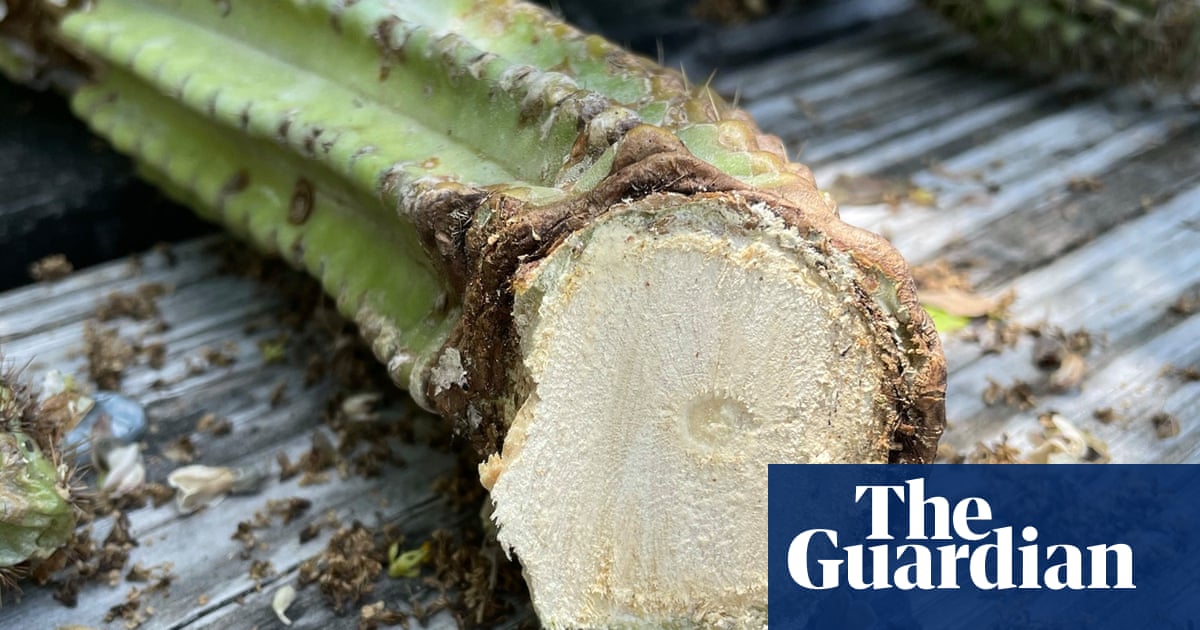Scientists in Florida have recorded what they say is the first local extinction of a species caused by sea-level rise.
The climate emergency has killed off the Key Largo tree cactus growing naturally in the US through salt water inundation and soil depletion from hurricanes, according to researchers from the Florida Museum of Natural History, and Miami’s Fairchild Tropical Botanic Garden.
The species, which is now found only on a handful of remote Caribbean islands, northern Cuba and areas of the Bahamas, was already down to only a single population of six stems in the Florida Keys.
Those were removed to a greenhouse in 2021 to ensure the species’ survival, and frequent searches since have revealed no naturally growing Key Largo cacti. There is also little prospect of it re-establishing itself, despite “tentative plans” with the Florida department of environmental protection (DEP) for a small-scale replanting project.
About 90% of the low-lying Florida Keys island chain is at 5ft of elevation or less, with Nasa predicting future ocean rise of up to 7ft by 2100.
“Unfortunately, the Key Largo tree cactus may be a bellwether for how other low-lying coastal plants will respond to climate change,” said Fairchild botanist Jennifer Possley, lead author of a study published Tuesday in the journal of the Botanical Research Institute of Texas that chronicled the species’ decline.
The scientists say they noticed the population of Pilosocereus millspaughii in the Keys was already ailing in 1992, when it was first discovered to be a separate species to the Key Tree cactus, which is similar in appearance and present elsewhere in the Keys, although also in declining numbers.
A storm surge event in the lower Keys in 2005 established a link between water salinity and mortality of cacti. Subsequent surges from hurricanes and exceptionally high tides eroded the layers of soil and organic matter close to the shore where the Key Largo cacti were growing.
Additionally, researchers found mammals deprived of fresh drinking water elsewhere were eating the moisture-retaining plants and causing even more harm.
“In 2011, we started seeing saltwater flooding from king tides in the area,” said study co-author James Lange, a research botanist at Fairchild, and member of a team that returned annually to gauge the health of the cacti.
“We’d never seen cactus herbivory like this anywhere in the Lower Keys, where flooding has tended to be less extensive.”
He said salt-tolerant plants that had been previously restricted to brackish soils beneath the mangroves slowly began creeping up the outcrop, an indication that salt levels were increasing. Those conditions alone, he said, would have eventually killed the species, and within a few years almost 50% of the Key Largo cactus population had been lost.
Then, in 2017, category 4 Hurricane Irma swept over south Florida, destroying even more cacti and leaving the area flooded for weeks; followed by successive king tides in 2019, and the decision two years after that to “evacuate” the small number of stems that still survived.
Authors of the study, which included input from the DEP and researchers from the University of Florida, say the demise of the Key Largo tree cactus, and necessity of its removal, has given them a better idea of what to expect as more species are affected by the climate crisis.
Lange, however, said countering the damage to environments and preserving them would not be easy.
“Understanding and predicting the fate of rare organisms and their habitats in the face of climate change will likely be complicated by similar ecological interactions, and will require a multi-disciplinary approach to conservation,” he said.
Source link
